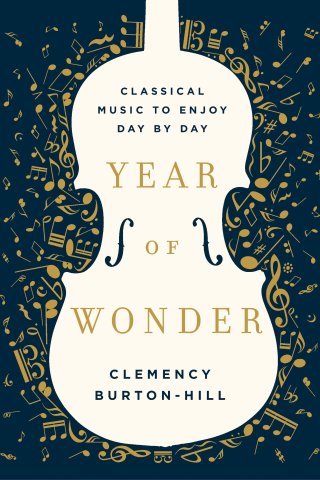“We are a music-making species — always have been, always will be — and music’s capacity to explore, express and address what it is to be human remains one of our greatest communal gifts.”
“Sound is sea: pattern lapping pattern… Matter delights in music, and became Bach,” the poet Ronald Johnson wrote as he contemplated matter, music, and the mind.
A generation after him, a young woman discovered that when the mind is suddenly unmattered, Bach remains.
One midwinter day shortly before the pandemic paralyzed the world, Clemency Burton-Hill — an underground London garage DJ turned BBC host turned creative director of America’s oldest public radio station for classical music, and a lifelong lover of Bach — suffered a catastrophic hemorrhage in her left frontal lobe. She was thirty-nine, her children one and five. She survived, but was left unable to see, move, or speak.
Clemency Burton Hill (Portrait: Matthew Septimus / WNYC)
Multiple surgeries and weeks of rehabilitation began restoring Clemency’s comprehension and sight, but the right side of her body remained paralyzed and her speech voided. Slowly, slowly, the words started forming again out of the primeval matter of the mind. Eventually, we spoke — Clemency still in her hospital bed, skull bandaged and face radiant with life, each word a triumph, as deliberate and precise as a Bach note. I found myself wondering what the world might look like if we spoke to each other that way, our words tender with our mortal fragility, resolute with reverence for the aliveness in us and in each other, this grand shared mystery.
Not long before her hemorrhage, Clemency had made a passionate case for a daily dose of music as “a form of sonic soul maintenance” in her book Year of Wonder: Classical Music to Enjoy Day by Day (public library) — the music counterpart to Tolstoy’s Calendar of Wisdom and poet Ross Gay’s yearlong journal of delights. She wrote:
We are a music-making species — always have been, always will be — and music’s capacity to explore, express and address what it is to be human remains one of our greatest communal gifts… We evolved by coming together around the fire every night, singing songs and telling stories — invariably, telling stories through singing songs. That’s what our ancestors did; that’s how they made sense of the world and each other; that’s how they learned how to be.
It is an impulse that is still fundamental to who we are.
Fitting, the musical calendar of wonder begins with a Bach liturgy for January 1. Bach punctuates Clemency’s sonic year as a maker of music that “contains all of everything” and maker of “the blueprint for everything that was to come,” his influence reverberating through the hallway of time to shape genres as diverse as techno and funk. As the year unfolds, there are his Goldberg Variations with their exquisite mathematical precision, rumored to have been composed as an insomnia cure, their original manuscript bearing an inscription in Bach’s hand: “Prepared for the soul’s delight of lovers of music.”
There is his violin solo in E major that always comes as “a shot of musical caffeine” for Clemency: “In just a hundred seconds or so,” she writes, “this piece has the effect of apparently rearranging the molecules around me, making me see and think more clearly.”
There is his Ave Maria in early June, and his Partita no. 2 in D Minor on my late-summer birthday, and on my father’s autumnal equinox birthday a chorale cantata translating to “As a father has mercy.” (This, too, is Bach’s singular enchantment — how we project ourselves onto him and focus our own existence through his lens.)
Bach’s diurnal presence took on a new form after Clemency’s hemorrhage and became an embodied testament to philosopher Josef Pieper’s soulful case for how Bach can save your soul. At first, with her life so brutally transformed, she found it difficult to even listen to his music, hearing in it the echoes of her former life and former self. But she eventually came to see Bach for what he always had been and always would be — the existential soundtrack to aliveness itself.
Along the protracted trajectory of her recovery, both physical and psychological, Clemency began not only listening to but playing Bach every single day. “To recover the Bach in me,” she says in her stunning BBC piece about the experience — her first word-work since that savage January day, and the most moving audio artwork I have heard in epochs.
With her hard-won words, she invites the voices of people from various walks of life, people who all play Bach daily to move through their own very different and differently challenging lives — from an elderly organist in Germany to a young cellist and community organizer in Kenya’s largest slum: Bach as meditation, Bach as motivation, Bach as calibration of being. (When we spoke that day from the hospital, I shared with Clemency something hardly anyone in my life knew: that I was a secret cellist, still learning the instrument, playing a single Bach cello suite day after day as I waded through a very different personal loss.)
Nina, my cello.
In exploring Bach as a daily ritual, Clemency draws on the legacy of the legendary Spanish Catalan cellist and conductor Pablo Casals (December 29, 1876–October 22, 1973) — Yo-Yo Ma’s hero and formative influence, widely considered the greatest cellist of all time, who at the age of ninety-three reflected so tenderly on how working with love prolongs your life. Casals began his autobiography by sharing the daily practice that had anchored him to his own life since the day he first fell under Bach’s enchantment:
For the past eighty years I have started each day in the same manner. It is not a mechanical routine but something essential to my daily life. I go to the piano, and I play two preludes and fugues of Bach. I cannot think of doing otherwise. It is a sort of benediction on the house… It is a rediscovery of the world of which I have the joy of being a part. It fills me with awareness of the wonder of life, with a feeling of the incredible marvel of being a human being. The music is never the same for me, never. Each day it is something new, fantastic and unbelievable.
Pablo Casals
In Bach, Casals found an analogue for the miracle of nature. Echoing the poet and philosopher of science Loren Eiseley’s poignant observation that “we forget that nature itself is one vast miracle transcending the reality of night and nothingness… that each one of us in his personal life repeats that miracle,” Casals reflected on his profound personal connection to nature, of which his love of music was an expression — a way to feel more alive, more awake to the wonder of aliveness:
I do not think a day passes in my life in which I fail to look with fresh amazement at the miracle of nature. It is there on every side. It can be simply a shadow on a mountainside, or a spider’s web gleaming with dew, or sunlight on the leaves of a tree. I have always especially loved the sea. Whenever possible, I have lived by the sea.
The sea and Bach were always intimately connected for Casals, who fell under Bach’s spell at thirteen. One saltwater-scented afternoon, his father bought him his first full-sized cello — an instrument looked down upon in Bach’s day, too unworthy to compose solos for. Father and son then walked to a musty old music shop in the nearby harbor — Casals never forgot “its faint smell of the sea” — where he acquired his other great portal into the “magic and mystery” of music: a yellowed sheaf of scores, faded with age, bearing the title Six Suites for Violoncello Solo, imprinted with “J.S. Bach.” They became his most cherished music.
A lifetime later, looking back on how these cello suites had grown to be regarded as “academic works, mechanical, without warmth” in the century and a half since Bach’s death in 1750, and how no cellist or violinist had performed any of them in its entirety, Casals exclaimed:
How could anyone think of them as being cold, when a whole radiance of space and poetry pours forth from them! They are the very essence of Bach, and Bach is the essence of music.
Casals and his generation had awakened to the radiance of Bach thanks to his contemporary and hero Albert Schweitzer (January 14, 1875–September 4, 1965). Although Schweitzer received the Nobel Peace Prize for his ethical-ecological philosophy of “Reverence for Life” — the philosophy that inspired sea-serenader Rachel Carson to dedicate her epoch-making Silent Spring to Schweitzer — music always remained his greatest animating passion.
Albert Schweitzer, early 1900s.
Schweitzer — born almost exactly 200 years after Bach, to a minister and a pastor’s daughter — was five when his father began giving him music lessons on the piano inherited from his organist grandfather. Before his legs were long enough to reach the pedals, the boy began playing the organ himself. By nine, he was substituting for the church organist at service.
And then he discovered Bach.
During the Classical and early Romantic eras that followed Bach’s, his music fell out of favor and slipped into academic obscurity, relegated to a thing of theory, syphoned of transcendence. The young Schweitzer, serving as an organist to the Paris Bach Society that he had co-founded while completing his doctoral dissertation on the spirituality of Kant’s philosophy at the Sorbonne, grew increasingly restless at this erasure of wonder and took it upon himself to remedy it. In those first years of the twentieth century, the only Bach material available to French readers — even those who cherished and played music — were only dry biographies that presented him as a cold mathematician of sound. A musician himself, Schweitzer longed to talk to other musicians and lovers of music about “the real nature of Bach’s music and its interpretation” — to resurrect Bach the artist, the enchanter, the virtuoso of feeling, the prophet of transcendence.
In 1902, Schweitzer spent his autumn vacation writing an essay to get the students at the Paris Conservatory excited about Bach. He quickly found himself with much more to say — so much more that, after using his meager funds to purchase a copy of Bach’s hard to find and extravagantly priced complete works, he spent the next two years turning the essay into a 455-page book that introduced the world to Bach the artist; the book that magnetized a largehearted embrace when Casals met Schweitzer in the 1930s.
In it, Schweitzer rescued Bach from the theorists who had coopted him for their ideologies of “pure music” — composition devoid of poetry, created solely as a mathematical exercise in harmonic perfection — and instead helped people see him as “a poet and painter in sound” who uses the language of music to paint entire landscapes of thought and feeling. He wrote:
The impulse to express poetic and pictorial concepts is the essence of music. It addresses itself to the listener’s creative imagination and seeks to kindle in him the feelings and visions with which the music was composed. But this it can do only if the person who uses the language of sound possesses the mysterious faculty of rendering thoughts with a superior clarity and precision. In this respect Bach is the greatest of the great… A soul that longs for peace out of the world’s unrest and has itself already tasted peace allows others to share its experience in this music.
Schweitzer observed that there are two types of artists: the subjective, who use their personality as the wellspring of their art and live as “a law unto themselves,” and the objective, whose “artistic personality exists independently of the human” and whose art is “not impersonal, but superpersonal,” channeling the universal and the eternal through the vessel of their being. Bach was such an artist:
It is as if he felt only one impulse, to express again what he already finds in existence, but to express it definitively, in unique perfection. It is not he who lives, it is the spirit of the time that lives in him. All the artistic endeavours, desires, creations, aspirations and errors of his own and of previous generations are concentrated and worked out to their conclusion in him.
[…]
Bach is thus a terminal point. Nothing comes from him; everything merely leads up to him…. This genius was not an individual, but a collective soul. Centuries and generations have laboured at this work, before the grandeur of which we halt in veneration. To anyone who has gone through the history of this epoch and knows what the end of it was, it is the history of that culminating spirit, as it was before it objectivated itself in a single personality.
He adds a poetic corollary to this eternal and aggregate nature of art:
We feel it to be a matter of course that some day a Bach shall come in whom all those, other Bachs shall find a posthumous existence.
The book project interrupted the young Schweitzer’s theological writings and accompanied him on the path to medical school, with Bach as his bridge between spirituality and science. Struggling financially, he paid for his medical education with proceeds from the Bach book and income from his Bach concerts.
Albert Schweitzer at his organ. LP cover art by Ben Shahn.
His passionate appreciation of Bach left him. A decade later, as he headed for Africa to do the work out of which his philosophy of “Reverence for Life” arose — the work that earned him the Nobel Peace Prize and Rachel Carson’s devotion — Schweitzer brought with him a pedal piano the Paris Bach Society had given him as the closest thing to an organ one could bring to the tropics so he could continue his daily Bach. In his autobiography, he reflected:
During the many peaceful hours I was able to spend with Bach during my four and a half years in the jungle I had penetrated deeper into the spirit of his works.
Hatcheting her way through the synaptic jungle, Clemency too found herself in more intimate contact with the spirit of Bach’s music, unfolding “the ultimate expression of anything and everything” — aliveness and mortality cleaved into the edge of being, the edge on which we are all perched every instant of every living day, each moment more precarious than we dare think, each more precious than we dare feel. How poignant to reread now this passage from Year of Wonder — a book Clemency wrote out of her belief, then only mental but not yet matter-tested, that “music holds the mystery of being alive”; that something singular happens “when we open up our lives to let such music in”:
Bach’s brain was clearly some kind of supercomputer: he wrote at least three thousand pieces whilst holding down a number of jobs, a couple of wives and twenty children.
[…]
The essence of what makes Bach the greatest eludes words, but it lies, I think, in the way he combines technical precision with socking great emotion. People often describe Bach as ‘mathematical’ because of the complex, intricate patterns in his music. But he is not clinical or scientific: as a human being he knew intense joy but also wild grief, and there’s never been a composer or songwriter more attuned to the vagaries of the human heart.
donating = loving
For 15 years, I have been spending hundreds of hours and thousands of dollars each month to keep Brain Pickings going. It has remained free and ad-free and alive thanks to patronage from readers. I have no staff, no interns, no assistant — a thoroughly one-woman labor of love that is also my life and my livelihood. If this labor makes your life more livable in any way, please consider aiding its sustenance with donation.
newsletter
Brain Pickings has a free weekly newsletter. It comes out on Sundays and offers the week’s most inspiring reading. Here’s what to expect. Like? Sign up.





